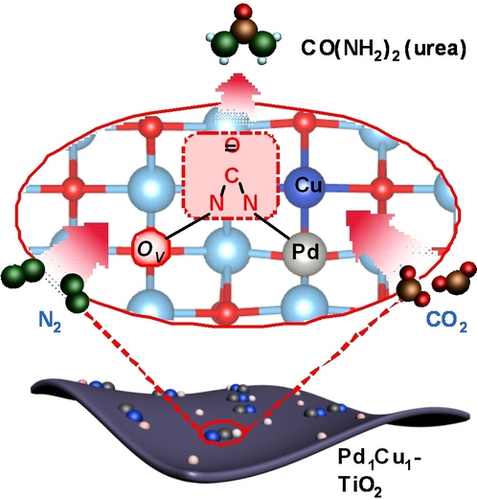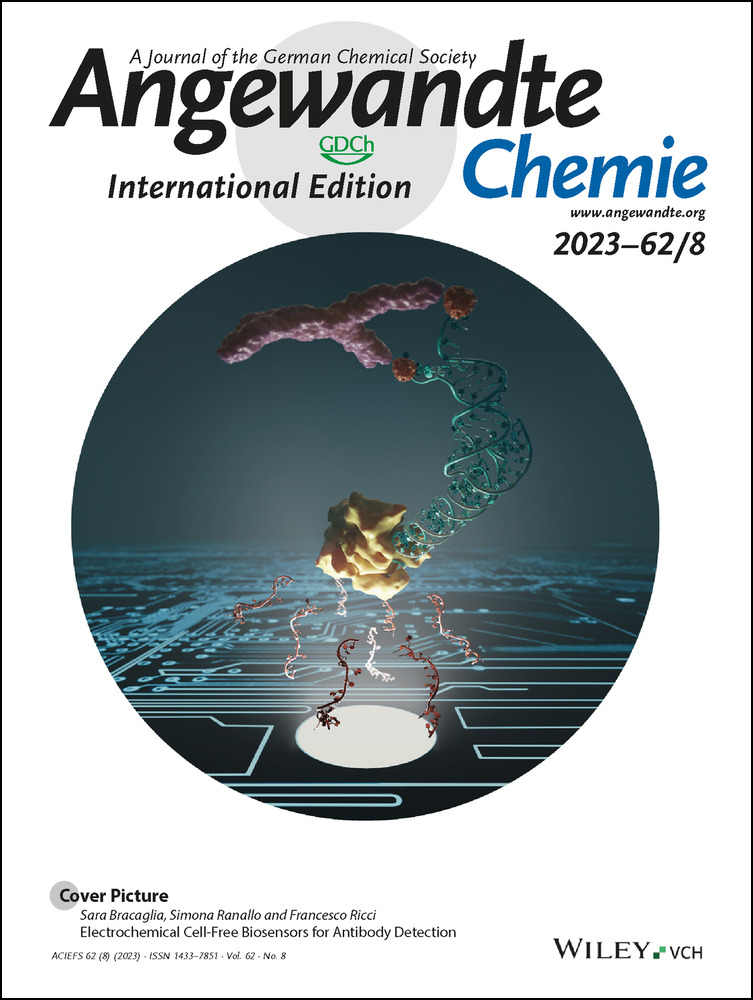Single-Atom or Dual-Atom in TiO2 Nanosheet: Which is the Better Choice for Electrocatalytic Urea Synthesis?
Lu Pan
Department of Physics, School of Physical Science and Engineering, Beijing Jiaotong University, Beijing, 100044 P. R. China
These authors contributed equally to this work.
Search for more papers by this authorJingnan Wang
School of Chemical Engineering and Technology, Tianjin University, Molecular Plus and Collaborative Innovation Center of Chemical Science and Engineering, Tianjin, 300072 P. R. China
These authors contributed equally to this work.
Search for more papers by this authorDr. Fei Lu
College of Physical Science and Technology, Yangzhou University, Yangzhou, 225002 P. R. China
These authors contributed equally to this work.
Search for more papers by this authorQiang Liu
School of Chemical Engineering and Technology, Tianjin University, Molecular Plus and Collaborative Innovation Center of Chemical Science and Engineering, Tianjin, 300072 P. R. China
These authors contributed equally to this work.
Search for more papers by this authorYuhang Gao
Key Laboratory of Photochemistry Institute of Chemistry, Chinese Academy of Sciences, Beijing, 100190 P. R. China
Search for more papers by this authorYan Wang
Department of Physics, School of Physical Science and Engineering, Beijing Jiaotong University, Beijing, 100044 P. R. China
Search for more papers by this authorJingzhe Jiang
School of Chemical Engineering and Technology, Tianjin University, Molecular Plus and Collaborative Innovation Center of Chemical Science and Engineering, Tianjin, 300072 P. R. China
Search for more papers by this authorChao Sun
School of Chemical Engineering and Technology, Tianjin University, Molecular Plus and Collaborative Innovation Center of Chemical Science and Engineering, Tianjin, 300072 P. R. China
Search for more papers by this authorDr. Jian Wang
Research Center for Magnetic and Spintronic Materials, National Institute for Materials Science, Tsukuba, 305-0047 Japan
Search for more papers by this authorCorresponding Author
Prof. Xi Wang
Department of Physics, School of Physical Science and Engineering, Beijing Jiaotong University, Beijing, 100044 P. R. China
Search for more papers by this authorLu Pan
Department of Physics, School of Physical Science and Engineering, Beijing Jiaotong University, Beijing, 100044 P. R. China
These authors contributed equally to this work.
Search for more papers by this authorJingnan Wang
School of Chemical Engineering and Technology, Tianjin University, Molecular Plus and Collaborative Innovation Center of Chemical Science and Engineering, Tianjin, 300072 P. R. China
These authors contributed equally to this work.
Search for more papers by this authorDr. Fei Lu
College of Physical Science and Technology, Yangzhou University, Yangzhou, 225002 P. R. China
These authors contributed equally to this work.
Search for more papers by this authorQiang Liu
School of Chemical Engineering and Technology, Tianjin University, Molecular Plus and Collaborative Innovation Center of Chemical Science and Engineering, Tianjin, 300072 P. R. China
These authors contributed equally to this work.
Search for more papers by this authorYuhang Gao
Key Laboratory of Photochemistry Institute of Chemistry, Chinese Academy of Sciences, Beijing, 100190 P. R. China
Search for more papers by this authorYan Wang
Department of Physics, School of Physical Science and Engineering, Beijing Jiaotong University, Beijing, 100044 P. R. China
Search for more papers by this authorJingzhe Jiang
School of Chemical Engineering and Technology, Tianjin University, Molecular Plus and Collaborative Innovation Center of Chemical Science and Engineering, Tianjin, 300072 P. R. China
Search for more papers by this authorChao Sun
School of Chemical Engineering and Technology, Tianjin University, Molecular Plus and Collaborative Innovation Center of Chemical Science and Engineering, Tianjin, 300072 P. R. China
Search for more papers by this authorDr. Jian Wang
Research Center for Magnetic and Spintronic Materials, National Institute for Materials Science, Tsukuba, 305-0047 Japan
Search for more papers by this authorCorresponding Author
Prof. Xi Wang
Department of Physics, School of Physical Science and Engineering, Beijing Jiaotong University, Beijing, 100044 P. R. China
Search for more papers by this authorGraphical Abstract
Abstract
As rising star materials, single-atom and dual-atom catalysts have been widely reported in the electro-catalysis area. To answer the key question: single-atom and dual-atom catalysts, which is better for electrocatalytic urea synthesis? we design two types of catalysts via a vacancy-anchorage strategy: single-atom Pd1−TiO2 and dual-atom Pd1Cu1−TiO2 nanosheets. An ultrahigh urea activity of 166.67 molurea molPd−1 h1 with the corresponding 22.54 % Faradaic efficiency at −0.5 V vs. reversible hydrogen electrode (RHE) is achieved over Pd1Cu1−TiO2, which is much higher than that of Pd1−TiO2. Various characterization including an in situ diffuse reflectance infrared Fourier transform spectroscopy (DRIFTS) and theoretical calculations demonstrate that dual-atom Pd1Cu1 site in Pd1Cu1−TiO2 is more favorable for producing urea, which experiences a C−N coupling pathway with a lower energy barrier compared with Pd1 in Pd1−TiO2.
Conflict of interest
The authors declare no conflict of interest.
Open Research
Data Availability Statement
Data sharing is not applicable to this article as no new data were created or analyzed in this study.
Supporting Information
As a service to our authors and readers, this journal provides supporting information supplied by the authors. Such materials are peer reviewed and may be re-organized for online delivery, but are not copy-edited or typeset. Technical support issues arising from supporting information (other than missing files) should be addressed to the authors.
| Filename | Description |
|---|---|
| anie202216835-sup-0001-misc_information.pdf1.9 MB | Supporting Information |
Please note: The publisher is not responsible for the content or functionality of any supporting information supplied by the authors. Any queries (other than missing content) should be directed to the corresponding author for the article.
References
- 1
- 1aG. Soloveichik, Nat. Catal. 2019, 2, 377–380;
- 1bX. Sun, S. Jiang, H. Huang, H. Li, Ba. Jia, T. Ma, Angew. Chem. Int. Ed. 2022, 61, e202204880; Angew. Chem. 2022, 134, e202204880.
- 2
- 2aC. Chen, X. R. Zhu, Wen, Y. Zhou, L. Zhou, H. Li, L. Tao, Q. L. Li, S. Q. Du, T. T. Liu, D. F. Yan, C. Xie, Y. Q. Zou, Y. Y. Wang, R. Chen, J. Huo, Y. F. Li, J. Cheng, H. Su, X. Zhao, W. R. Cheng, Q. H. Liu, H. Z. Lin, J. Luo, J. Chen, M. D. Dong, K. Cheng, C. G. Li, S. Y. Wang, Nat. Chem. 2020, 12, 717–724;
- 2bJ. Shao, N. Meng, Y. Wang, B. Zhang, K. Yang, C. Liu, Y. Yu, B. Zhang, Angew. Chem. Int. Ed. 2022, 61, e202213009; Angew. Chem. 2022, 134, e202213009;
- 2cY. Wang, H. Li, W. Zhou, X. Zhang, B. Zhang, Y. Yu, Angew. Chem. Int. Ed. 2022, 61, e202202604; Angew. Chem. 2022, 134, e202202604;
- 2dX. Zhang, X. Zhu, S. Bo, C. Chen, M. Qiu, X. Wei, N. He, C. Xie, W. Chen, J. Zheng, P. Chen, S. P. Jiang, Y. Li, Q. Liu, S. Wang, Nat. Commun. 2022, 13, 5337.
- 3
- 3aX. Zhu, X. Zhou, Y. Jing, Y. Li, Nat. Commun. 2021, 12, 4080;
- 3bS.-K. Geng, Y. Zheng, S.-Q. Li, H. Su, X. Zhao, J. Hu, H.-B. Shu, M. Jaroniec, P. Chen, Q.-H. Liu, S.-Z. Qiao, Nat. Energy 2021, 6, 904–912;
- 3cC. D. Lv, L. X. Zhong, H. J. Liu, Z. W. Fang, C. S. Yan, M. X. Chen, Y. Kong, C. Lee, D. B. Liu, S. Z. Li, J. W. Liu, L. Song, G. Chen, Q. Y. Yan, G. H. Yu, Nat. Sustainability 2021, 4, 868–876;
- 3dL. Wang, Y. Zhu, Y. Wen, S. Li, C. Cui, F. Ni, Y. Liu, H. Lin, Y. Li, H. Peng, B. Zhang, Angew. Chem. Int. Ed. 2021, 60, 10577–10582; Angew. Chem. 2021, 133, 10671–10676.
- 4
- 4aM. L. Yuan, J. W. Chen, Y. L. Bai, Z. J. Liu, J. X. Zhang, T. K. Zhao, Q. Wang, S. W. Li, H. Y. He, G. J. Zhang, Angew. Chem. Int. Ed. 2021, 60, 10910–10918; Angew. Chem. 2021, 133, 11005–11013;
- 4bW.-K. Han, J.-X. Wei, K. Xiao, T. Ouyang, X. Peng, S. Zhao, Z.-Q. Liu, Angew. Chem. Int. Ed. 2022, 61, e202206050; Angew. Chem. 2022, 134, e202206050;
- 4cJ. Geng, S. Ji, M. Jin, C. Zhang, M. Xu, G. Wang, C. Liang, H. Zhang, Angew. Chem. Int. Ed. 2022, 61, e202210958; Angew. Chem. 2022, 134, e202210958.
- 5
- 5aM. Xia, C. Mao, A. Gu, A. A. Tountas, C. Qiu, T. E. Wood, Y. F. Li, U. Ulmer, Y. Xu, C. J. Viasus, J. Ye, C. Qian, G. Ozin, Angew. Chem. Int. Ed. 2022, 61, e202110158; Angew. Chem. 2022, 134, e202110158;
- 5bX. Wei, X. Wen, Y. Liu, C. Chen, C. Xie, D. Wang, M. Qiu, N. He, P. Zhou, W. Chen, J. Cheng, H. Lin, J. Jia, X.-Z. Fu, S. Wang, J. Am. Chem. Soc. 2022, 144, 11530–11535.
- 6
- 6aJ. Y. Zheng, Y. H. Lyu, M. Qiao, J. P. Veder, R. D. Marco, J. Bradley, R. L. Wang, Y. F. Li, A. B. Huang, S. P. Jiang, S. Y. Wang, Angew. Chem. Int. Ed. 2019, 58, 18604–18609; Angew. Chem. 2019, 131, 18777–18782;
- 6bJ. Y. Zheng, Y. H. Lyu, M. Qiao, R. L. Wang, Y. Y. Zhou, H. Li, C. Chen, Y. F. Li, H. J. Zhou, S. P. Jiang, S. Y. Wang, Chem 2019, 5, 617–633;
- 6cJ. Y. Zheng, L. Jiang, Y. H. Lyu, S. P. Jiang, S. Y. Wang, Energy Environ. Mater. 2022, 5, 452–457;
- 6dY. J. Zhai, P. Han, Q. B. Yun, Y. Y. Ge, X. Zhang, Y. Chen, H. Zhang, eScience 2022, 2, 467–485.
- 7F. Lu, D. Yi, S. J. Liu, F. Zhan, B. Zhou, L. Gu, D. Golberg, X. Wang, J. N. Yao, Angew. Chem. Int. Ed. 2020, 59, 17712–17718; Angew. Chem. 2020, 132, 17865–17871.
- 8D. Yi, F. Lu, F. Zhang, S. Liu, B. Zhou, D. Gao, X. Wang, J. Yao, Angew. Chem. Int. Ed. 2020, 59, 15855–15859; Angew. Chem. 2020, 132, 15989–15993.
- 9T. Sasaki, S. Nakano, S. Yamauchi, M. Watanabe, Chem. Mater. 1997, 9, 602–608.
- 10D. Zhu, L. H. Zhang, R. E. Ruther, R. J. Hamers, Nat. Mater. 2013, 12, 836–841.
- 11M. Rahmatullah, T. R. C. Boyde, Clin. Chim. Acta 1980, 107, 3–9.
- 12H. Yan, C. Tian, L. Wang, A. Wu, M. Meng, L. Zhao, H. Fu, Angew. Chem. Int. Ed. 2015, 54, 6325–6329; Angew. Chem. 2015, 127, 6423–6427.
- 13D. J. Zang, Q. Li, G. Y. Dai, M. Y. Zeng, Y. C. Huang, Y. G. Wei, Appl. Catal. B 2021, 281, 119426.
- 14X. R. Zhu, X. C. Zhou, Y. Jing, Y. F. Li, Nat. Commun. 2021, 12, 4080.
- 15Z. Tao, C. L. Rooney, Y. Liang, H. Wang, J. Am. Chem. Soc. 2021, 143, 19630–19642.
- 16B. H. Ko, B. Hasa, H. Shin, F. Zhao, J. Am. Chem. Soc. 2022, 144, 1258–1266.
- 17Y. Zhu, S. F. Yuk, J. Zheng, M.-T. Nguyen, M.-S. Lee, J. Szanyi, L. Kovarik, Z. Zhu, M. Balasubramanian, V.-A. Glezakou, J. L. Fulton, J. A. Lercher, R. Rousseau, O. Y. Gutiérrez, J. Am. Chem. Soc. 2021, 143, 5540–5549.
- 18R. Keuleers, H. O. Desseyn, B. Rousseau, C. J. V. Alsenoy, J. Phys. Chem. A 1999, 103, 4621–4630.
- 19C. D. Lv, L. X. Zhong, H. J. Liu, Z. W. Fang, C. S. Yan, M. X. Chen, Y. Kong, C. Lee, D. B. Liu, S. Z. Li, J. W. Liu, L. Song, G. Chen, Q. Y. Yan, G. H. Yu, Nat. Sustainability 2021, 4, 868–876.
- 20G. Ramis, G. Busca, F. Bregani, Appl. Catal. 1990, 64, 259–278.
- 21M. Manivannan, S. Rajendran, Int. J. Eng. Sci. Technol. 2011, 3, 8048–8060.





